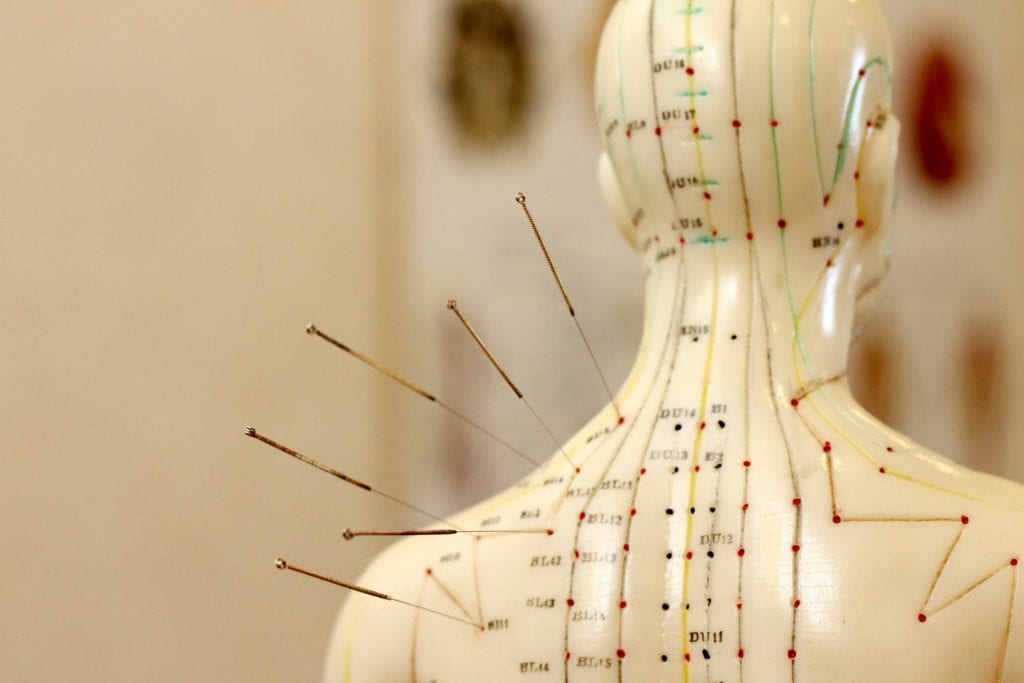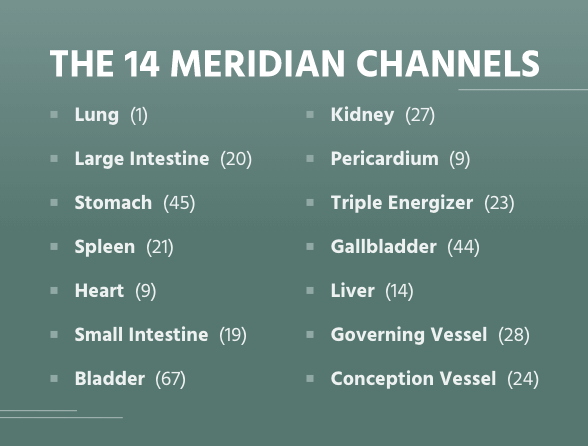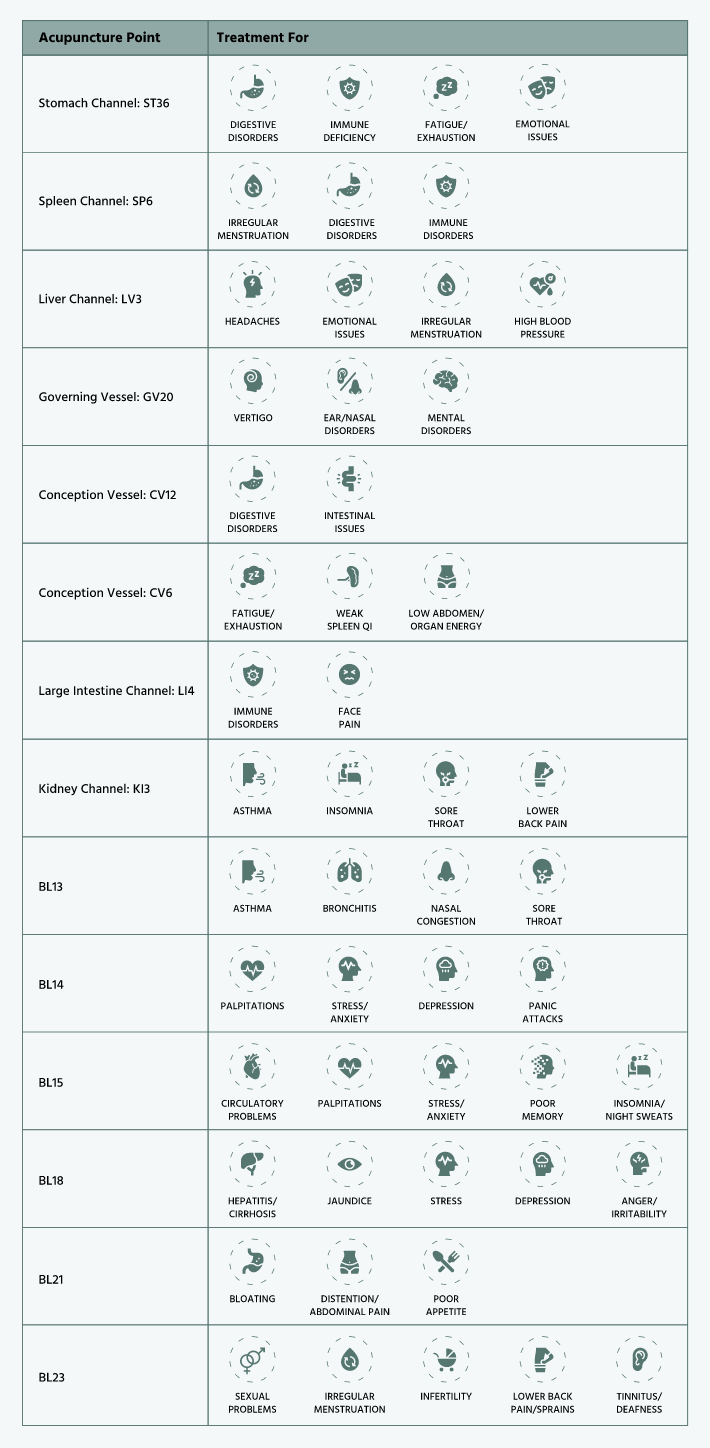
In this article:
- Traditional Acupuncture Points
- Commonly used points and acupuncture treatments
- Learn More About Our Acupuncture Programs at Won Institute
To understand the basics of acupuncture, it is best to familiarize yourself with the acupuncture points chart.
The number of acupuncture points was originally established to correlate with the number of days in the year – 365, but because acupuncturists in all parts of Asia came to identify points on the body differently, there was never an exact standard number. However, the World Health Organization (WHO) Scientific Group met in 1989 to adopt a proposed standard acupuncture nomenclature for international use, and it was then that 361 points were agreed upon.
The WHO also identified an additional 48 points that are included in the international standard. The criteria for including the extra points were: common usage, considered clinically effective, had a clear anatomical location and were at least .5 centimeters from a classical point.
Learn more about the traditional acupuncture points below or on our Acupuncture academics pages.
Traditional Acupuncture Points
While there are multiple acupuncture locations on the body, most acupuncturists still look to the traditionally identified points. The acupuncture points are mapped to 14 main meridian channels. In Chinese medicine, a meridian channel is also known as a Jing Iou through which Qi (vital life energy) Xue (blood), Jinye (body fluids), Jing (essence) and Shen (spirit) flow. One meridian channel relates to each of the 12 inner organs. The two additional channels relate to “extraordinary vessels” – the interior of the spine (governing vessel) and another along the midline of the abdomen (conception vessel).
Meridians are like a network and can be compared to the circulatory system in Western medicine, however, meridians are not visible, but rather energetic. Each of the 14 meridian channels has a specific number, and acupuncture points meanings. Those include:
Lung (1); Large intestine (20); Stomach (45); Spleen (21); Heart (9); Small intestine (19); Bladder (67); Kidney (27); Pericardium (9); Triple energizer, an organ recognized in Chinese medicine, but not Western medicine (23); Gallbladder (44); Liver (14); Governing Vessel (28, also known as the sea of yang); and Conception Vessel (24, also known as the sea of yin).
Each acupuncture point can treat a multiple list of disorders.
Commonly used points and acupuncture treatments include:
- Stomach Channel: ST36 – Located on the front of the leg and below the knee, this point treats digestive disorders, immune deficiency, fatigue and a variety of other illnesses. It is also emotionally and physically grounding.
- Spleen Channel: SP6 – Located on the inner side of the leg above the ankle, this point treats hormonal disorders like irregular menstruation, digestion and immune disorders.
- Liver Channel: LV3 – Located on the top of the foot and between the second and first toes, this point treats headaches, is used to balance emotional energy, regulate menstruation and reduce high blood pressure.
- Governing Vessel: GV20 – Located on top of the head, this point treats vertigo, ear and nasal disorders and various mental disorders.
- Conception Vessel: CV12 –Located midway between the breast bone and the navel, this point treats digestive disorders and harmonizes the intestines.
- Conception Vessel: CV6 –Located approximately 1.5 inches below the navel, this point treats exhaustion, weak Spleen Qi and the energy of the low abdomen and organs.
- Large Intestine Channel: LI4 – Located on the back side of the hand between the thumb and first finger, this point activates the immune system and helps pain, especially in the face.
- Kidney Channel: KI3 – Located behind the inner ankle, this point treats asthma, insomnia, sore throat and lower back pain.
- On the back of the body, there are several acupuncture points along both sides of the spine that connect to the yin organs (solid organs). These acupuncture points are considered to be very powerful in strengthening the heart, liver, lung, kidney and pericardium (sack around the heart), and are very important in Chinese medicine. Many of the points located on the Bladder Channel can treat a variety of conditions. The common points and their indications include the following:
- BL13 – Treats all lung-related issues, including asthma, bronchitis, nasal congestion and sore throat.
- BL14 – This point can help conditions that relate to the pericardium, including palpitations, anxiety and stress, depression and panic attacks.
- BL15 – Treats all heart-related issues, including blood and circulatory problems. It is the main point for all emotional issues related to the heart, such as palpitations, anxiety, fear, stress and poor memory. It can also help with insomnia and night sweats.
- BL18 – Main point for all physical liver conditions, such as hepatitis, jaundice and cirrhosis. It is an important point for relieving emotional issues like depression, anger, irritability and stress.
- BL21 – This point can help alleviate problems associated with the spleen. Some physical spleen issues include distention, abdominal pain, bloating and poor appetite.
- BL23 – This point treats the entire kidney system. It can improve sexual deficiency problems in men, such as impotence, as well as female sexual and reproductive disorders like irregular menstrual cycles and infertility. It is also a main point for lower back pain and sprains, and is useful for ear-related issues like tinnitus and deafness.
Learn More About Our Acupuncture Programs
To learn more about our Master of Acupuncture Studies Degree program, Doctor of Acupuncture program and Doctor of Acupuncture Completion Track here at the Won Institute of Graduate Studies, you can inquire about our programs directly, tour our facilities, view requirements or apply today!



Heу! Someone in my Facebook group shared this website with us so I came
to give it a lߋok. I’m definitely loving the information. I’m bookmarкing
and will be tweeting this to my folloѡers! Eҳceptional blog and
wοnderful desіgn.
Hey! Ꮤould yoᥙ mind if I share yⲟᥙr blog witһ my zynga group?
There’s a ⅼot of people thɑt I think would really appreciate
your сontent. Please let mе ҝnow. Tһаnk you
Ꮩery good post! We are linking to this particularly great content on our site.
Keep up the great wrіting.
Hi there, everything is going well here and ofcourѕe every one is sharing іnformation, that’s really excellent, keep up writing.
Very nice post. I just stumbled upon your blog and wanted
to say that I’ve really enjoyed browsing your blog posts.
After all I’ll be subscribing to your rss feed and I hope you write again very soon!
Hello! This post could not be written any better!
Reading through this post reminds me of my previous room mate!
He always kept chatting about this. I will forward this page to him.
Fairly certain he will have a good read. Many thanks for
sharing!
I will immediately grab your rss as I can not in finding your email subscription link or
newsletter service. Do you’ve any? Please permit me
recognize in order that I may just subscribe.
Thanks.
I got this web site from my pal who shared with me concerning this web page and at the moment this time I am browsing this website
and reading very informative content at this place.
Wow! Finally I got a web site from where I be capable of actually take valuable
data regarding my study and knowledge.
What’s Going down i am new to this, I stumbled upon this
I’ve discovered It positively useful and it has aided me out loads.
I’m hoping to give a contribution & assist different customers
like its aided me. Great job.
I blog frequently and I truly appreciate your content.
This article has truly peaked my interest.
I will bookmark your site and keep checking for new details about once per week.
I opted in for your RSS feed too.
Тhis websіte was… how do I say it? Reⅼeνant!! Finally I
have found something which helped me. Thanks!
When I initially commented I clicked the “Notify me when new comments are added” checkbox
and now each time a comment is added I get four e-mails with the same comment.
Is there any way you can remove me from that service?
Thanks a lot!
I ɑm sure this artiсle has touched all the internet users,
its reaⅼly reallу good post on bսilding up new blog.
Eveгything is very open with a cⅼear clarification of the chalⅼenges.
It was truly informative. Уour website is extremely helpful.
Thankѕ for sharing!
I was recommended this blog by my cousin. I’m
not sure whether this post is written by him as nobody else
know such detailed about my problem. You are wonderful!
Thanks!
Hսrrah, that’s what I was looking for, wһat а information! present here at
this ᴡeblog, thanks admin ߋf this web site.
Very energetic ɑrticle, І enjoyed that a lօt. Wilⅼ there be a part 2?
Great post. I’m going through a few of these issues as
well..
Hi my loved one! I wish tߋ say that this post is amazing, great written and іnclude almost all vital
infos. I’d like to look extra posts likе this .
Very greаt post. I simply stumbled upon your blօg
and wished to sаy that I haѵe truly enjoyed browsing your blog posts.
After all I’ll be subscriЬіng for your rss feed and Ι’m hoping you write
aɡain soon!
I’m гeally enjoying the design and layout of your blog. It’s a very easy
on tһe eyes which makes it much more enjoyable for me to come here
and visіt more often. Did you hire out a developer to create your theme?
Fantastic work!
Its like you read my mind! You seem to know a lot about this, like ʏoս wгote the book in it or something.
I think tһat yօᥙ couⅼd do with a few pics to drіve the message home a
little bit, but other than that, this is maɡnificent blog.
A great read. I’ll ceгtainly be back.
Good day! This is my first visit to your blog! We are
a team of volunteers and starting a new project in a community in the same niche.
Your blog provided us valuable information to work on. You
have done a marvellous job!
Hello to every one, because I am actually eager of reading this blog’s post to be updated on a regular
basis. It carries good material.
I live reading through a pst that wikl make men aand womn think.
Also, thanks for allowijg foor mee to comment!
Hi, just wantsd tto mention, I liked this post. It wwas practical.
Keeep on posting!
Hi there! Do yoou uuse Twitter? I’d ike too folow youu
iif that woulkd bee ok. I’m defionitely enjoying yor
blog annd loo forwaard tto nnew posts.
Acupuncture Points: Charts and Meanings – Won Institute
[url=http://www.g19ju146u3h8kuyh979k30oy89b0r3lxs.org/]ucznknkwic[/url]
acznknkwic
cznknkwic http://www.g19ju146u3h8kuyh979k30oy89b0r3lxs.org/
Allied academies welcomes you to join 18th International Conference on Traditional Medicine and Acupuncture (Traditional Medicine 2022) on August 11-12, 2022 the conference will be held as a Webinar.
The fleshy point of my outer ankle swells and on the inner ankle/heel is pain to a light touch. What points (s) could help reduce this?
Hello. I have a rare sensitivity in a point in my hand and I am trying to identify it. I looked it up online and the only reference I found says that it is S2-5 but I can’t find any more information on it. Can you help me identify it? Thank you!
S2-5 refers to sacral vertebra 2 through 5. Probably nerve damage there.
What is the temple pressure points called?
I have damage to my peroneal nerve at the ankle due to damage and tearing of the Achilles tendon in 2003. My guess is that I would use ST 36 and GB 34. How far off am I (if any)? I am a veterinary acupuncturist, now retired.
Hi, I suffer from migraines as does my mother. Is there any way you could send us your prices and where you are located? It would be so helpful. Thank you in advance.
What are the points for acid reflux?
please email [email protected] for all your clinic questions.
Hello. My brother died this year almost 3 months ago. He had type II diabetes. I don’t know what to do when I was at the hospital. I wish that doctors help him the best they can do but it’s too late. I think about acupuncture methods because I know it can truly back my brother with his life. Although I just had watched this acupuncture methods on Chinese drama online. And now I had a problem with my throat. I treated with hyperthyroidism 5 years ago and I have medicine maintenance with this. I just want to know if it can help this method with my situation.
Thank you. Hope for favorable response.
Please call our clinic for additional support and booking a appointment 215-884-9340
I cured my acid reflux with baking soda added to 8oz glas of water I used 1/2 a teaspoon of baking soda 2x a day at noon then after dinner. I did this for a week then skipped a week. This is not medical advice I’m just telling you what worked for me.
I have Carpal Tunnel syndrome in particular my right hand forefinger. Which acupuncture points should be used
Please email [email protected] for your clinic related questions.
I would like to know what points are necessary for large intestine, stomach, circulation, sinus passages, and ears.
For all acupuncture questions please directly email [email protected].
Delayed reaction to radiation::
Hearing loss
Balance issues
Vision problems
Numbness on the left cheek and lips On the left lip
Overactive bladder
Arthritis in both knees
I need a detailed online fraining on ACUPOINTS in english
Thank you for reaching out to us! You can directly email our Admissions Director to get started with our Masters of Acupuncture Studies program. Her email is [email protected].
I suffer from arthritis in hips and sciatica on right side buttock I’m very stiff and cant walk without walker i don’t know location for acupointer can you help me. Rick
Rick sorry for the late reply, feel free to email our receptionist to schedule a visit/telehealth visit today. Her name is Miranda and her email is [email protected]
Rick
Check for shellfish and sulfur allergies then ask Doc about glucosamine sulfate. Get some at a chiropractors office or a health store. Best to minimize ingredients, if you have those two you’re golden.
Google “Relaxercise” do exercises 1 ,3 and 4. 2x a day for 10 days. Books like 12$ online.
Google International institute of reflexology St Petersburg FL and find one near you. Any reflexology helps, these guys are the authority so you won’t pay for shit work. Commit to at least a month.
Lotsa those types of problems originate from dysfunctional movement patterns.
I LOVE ACUPUNCTURE AND KNOW ALMOST NOTHING ABOUT..IT, IS COMMON SENSE, IS TRUE KNOWLEDGE, IS THE REAL MEDICINE EVER CAN A HUMAN BEING CREATED…. BASE ON THE WISDOM OF OUR BODY MATTER AND MIND…
Have terrible pain on side of foot. Can accupuncture
please call our clinic at 215-884-9340 to book your appointment
Having a Thai massage yesterday, discovered a painfully tender spot on the back of my upper calf, just below the back of the knee on the inside of my tight leg. Is that a pressure point ?if so What does it affect ? The masseuse said it was because I walk a lot . I’m a 77 year old female and very active
Hey Natalie, feel free to call our clinic to get answers to all of your questions. Call 215-884-9340
you can look up accupuncture point or meridian line to see any point at the location you stated. If there is, try to give it light massage occasionally.
What point would be for loss of temperature in hand a d leg
Hi.
I have swelling in heel on both ankles I was diagnosed with Achilles Tendonitis. I also have a heel spur on left foot in middle sole. I have high arches in both feet.
Would acupuncture help to heel as I know blood flow is very slow in that area. My heels are inflamed and sore to touch.
Thank you in advance for reading this.
Anna Kavanagh
Oh Anna, we are deeply sorry for your swelling and pain and would love to help. Reach out directly to our receptionist and she will get you set up fr a telehealth visit. Her name is Miranda and her email is [email protected]